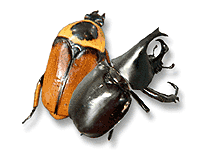Do you have an old terrarium lying around? Do you have a child whose pockets are full of slaters and ladybirds? Maybe it’s time to put them together and get into some serious insect collecting.
Insects are low-maintenance pets, cheap, quiet, and just a bit different. While small insects such as slaters and ladybirds are readily accessible from the garden, larger insects can be bought by mail order providing a whole new level of interaction.
Insects which are fascinating while still easy to keep include larger beetles such as the rhinoceros beetle, a bizarre-looking insect which features a horn-shaped “nose”, hisses when touched but is actually quite harmless. They don’t bite but they can fly so ensure the room is sealed when handling them. They breed well in captivity, producing a larvae like a thick white grub. Scarab beetles are another attractive, easy-care option.
Stick insects have also long been a favourite of insect pet-lovers. There are spiny, leafy and twiggy stick insects, a popular mail order choice being the spiny leaf insect.
Housing and space
Terrariums and old aquariums make ideal insect houses as long as they are securely covered. Fly screen is a good option keeping the insects in and allowing air circulation. Cheap plastic pet containers cost around $10-$15 from pet shops, or even larger kitchen canisters or bowl can be used if combined with a mesh lid. Stick insects like to climb branches so a taller (rather than wider) container is recommended.
Beetles are easy to look after as most live on top of, and breed in, potting mix. Look for a potting mix that doesn’t have added fertiliser but with a high ratio of sawdust. Layer to about 5cm then just put in your insects. Lightly mist the air with water each day.
For stick insects or spiny leaf insects it’s best to have a fairly tall container as a vase or jar of water is needed in the bottom to hold small branches of leaves. Use a layer of potting mix on the base, then the jar, then the leafy branches into the jar. Cover the top of the jar as insects have been known to drown in their own vase. Lightly mist the insects and leaves each day with an atomiser filled with water.
Health and breeding
With all insects it’s VITAL to avoid plants and leaves which have been sprayed with insecticide and NEVER use fly spray or similar insecticides in the same room as a pet insect. Remember to board your pets away from home for a few days if it is being sprayed by a pest controller.
Most individual insects will live only a few months or years but many can breed in their indoor shelters and provide another generation to enjoy. The Australian Insect Farm supplies comprehensive information sheets with each insect supplied, which details feeding, breeding, housing etc. for each type.
Further information
Contact The Australian Insect Farm, PO Box 26, Innisfail 4860, phone (07) 4063 3860.



